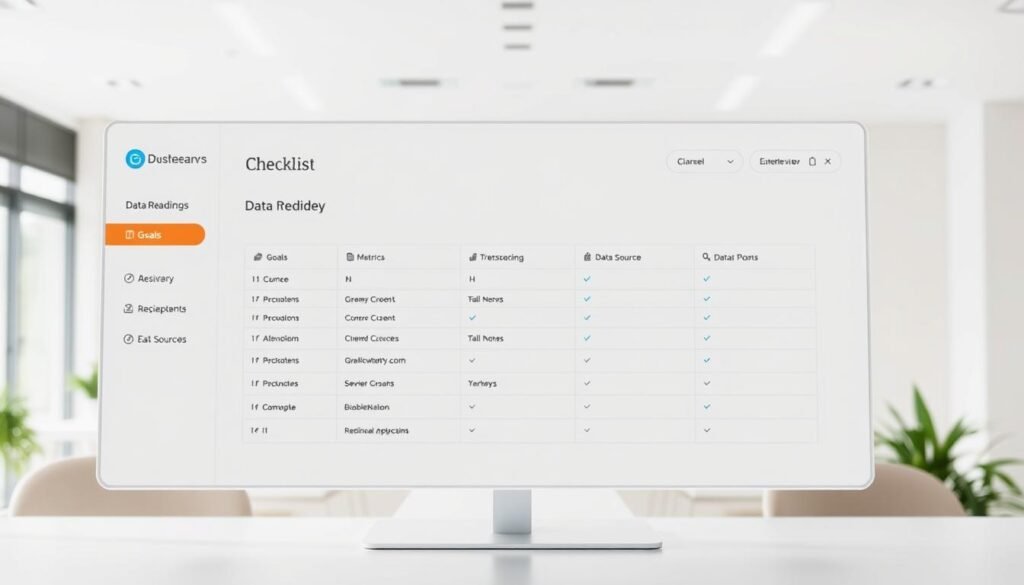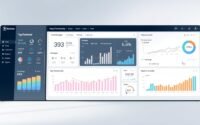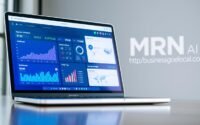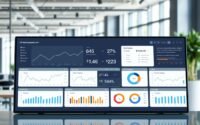Boost Business Growth with MRN AI Smart Business Dashboard
Can one simple view stop the busywork and give you faster, clearer decisions?
You’re here because you want speed, clearer insights, and less busywork. This guide shows a single dashboard that pulls scattered data into one place so your team can act quickly.
We walk you through a friendly, step‑by‑step plan to set up the tool, choose the right KPIs, and turn charts into real outcomes. Expect practical steps for forecasting sales, spotting anomalies, and automating repeat tasks without adding extra complexity.
By the end, you’ll know how to get started, keep your team committed, and use one dashboard to make informed decisions that matter — all without replacing your judgment.
Key Takeaways
- One unified dashboard reduces noisy apps and speeds decisions.
- Clear KPIs and simple setup make adoption easier for teams.
- Practical automations save time and cut repetitive tasks.
- Actionable insights turn charts into measurable outcomes.
- A short, repeatable step plan helps you keep improving week after week.
Start Here: What Small Business Owners Want and How MRN Answers It Right Now
When every minute counts, owners need one clear screen that tells them what matters. They want speed, fewer interruptions, and a single place to check status without hunting through files.
Match your search intent: faster decisions, clearer insights, less busywork. A focused home view shows revenue, CAC, and pipeline so you act instead of analyze.
Match your search intent: faster decisions, clearer insights, less busywork
You’re choosing right when you combine scattered data into a single, scannable screen. That clarity saves time and lowers the mental cost of switching between tools.
Why a simple AI dashboard beats scattered spreadsheets and apps
A simple dashboard syncs your accounts and creates instant insights. It reduces back-and-forth and surfaces exceptions so you fix problems before they affect performance.
- Turn multiple files into one view so decisions are faster and cleaner.
- Use drill-downs for depth only when you need it; avoid clutter.
- Make sure your home screen highlights the KPIs you check daily to match your business needs.
“A single-screen snapshot beats a day of tab-hopping.”
Ready to see the value? MRN and its dashboard approach centralize reporting and automate heavy lifting so small teams spend less time on routine tasks.
What Makes an AI Dashboard Different from “Just a Dashboard”
A modern dashboard can do more than display numbers—it can forecast, flag errors, and explain causes in plain language.
From mere snapshots to real, actionable work: predictive models use historical data to estimate what’s likely next week or next month. That helps your team plan inventory, staffing, and campaigns with fewer surprises.
From snapshots to smart insights: predictive, anomaly detection, and NLP
Predictive analytics spots trends before they become problems. Anomaly detection scans for sudden spikes or drops so users can investigate early and protect performance.
Natural language lets a user ask plain questions—like why revenue dipped—and get clear explanations with contributing metrics. This speeds up root-cause work without complex queries.
Human-in-the-loop: AI isn’t magic; you stay in control
Automation speeds routine processes, but oversight matters. Models can be confident and wrong when data is biased or incomplete.
Good features suggest actions; people decide. Keep data clean, set goals, and validate recommendations against context such as promos or holidays.
- Focus on a few high-impact insights, then offer drill-downs.
- Let data flow automatically so your team improves processes, not reports.
- When oversight stays tight, the system becomes a reliable assistant that boosts judgment.
“Tools that recommend but don’t override let teams act faster while staying accountable.”
MRN AI Smart Business Dashboard business growth software: What It Is and Why It’s Built for You
Connect once, see everything. Connect your accounts and watch revenue, CAC, retention, and other key metrics populate a single, scannable view. This centralization cuts manual pulls and makes reporting automatic.
The core capabilities are simple: link data sources, map kpis to clean visuals, surface trends, and let teams act faster with contextual insights. Forecasts and anomaly alerts help protect performance and cash while drill-downs keep details a click away.
Built for small teams
The tool prioritizes speed and low cost. Quick setup, intuitive widgets, and role-based views mean owners see top-line metrics while managers track day-to-day performance. Mobile-ready screens let you scan essentials in under a minute.
- Connect core data sources so metrics update automatically.
- Map KPIs to visuals with accessible colors and drill-downs.
- Forecasts & alerts help you spot trends and avoid surprises.
Get started now and see immediate value without a big implementation cost: https://businessgoeslocal.com/MRN-AI-Smart-Business-Dashboard
Strategy Before Tools: Define Goals, Metrics, and Data You’ll Trust
Start with what you want to change, not which tool to buy. Lead with clear goals so every metric you track maps to a real outcome.
Pick the right KPIs that prove progress: revenue, CAC, retention, productivity, and role-based metrics for managers and owners.
Pick the right KPIs
Write down the goals and link each to 2–3 kpis that show progress. Choose metrics you will actually use in weekly decisions.
Data readiness checklist
Make sure data is accurate, timely, and owned. Confirm where it lives, who can access it, and how updates occur to avoid bad conclusions.
Prioritize use cases
Rank opportunities by impact and feasibility. Focus first on revenue leakage, pipeline health, and churn risk—these often deliver quick wins.
- Document steps: what to connect, which kpis to display first, and who acts on alerts.
- Align across the organization early to keep processes consistent and honest.
- With goals set, setup mirrors what your team already measures and makes work visible.

| Step | What to check | Expected result |
|---|---|---|
| Define goals | List top 1–3 goals and linked kpis | Clear focus for reporting and action |
| Data audit | Confirm quality, access, and ownership | Trustworthy inputs for analysis |
| Prioritize use cases | Rank by impact and ease of implementation | Fast wins that scale |
| Document steps | Define connections, displays, and accountabilities | Faster setup and clearer outcomes |
Design Your First Dashboard the Right Way
Designing a first view is like arranging a storefront window—show what’s most valuable first. Start with a clear headline row of KPIs so anyone can see performance in seconds.
Layout and visuals that tell a story
Place key metrics at the top, charts below, and drill-downs on click. Use lines for trends, bars for comparisons, gauges for thresholds, and tables for detailed review. Let users filter by date, channel, or segment without crowding the main view.
Color, accessibility, and mobile best practices
Choose palettes with high contrast and colorblind-safe pairs. Keep text readable and controls large enough for thumbs. Test the design on a phone so leaders can check the business dashboard on the go.
Keep it uncluttered: essentials first, layers second
Limit features to what matters now. Group metrics by theme—acquisition, conversion, retention—so the way the dashboard reads matches meeting talk. Plan for small changes over time and add annotations that explain big moves.
- Essentials first: headline KPIs, then depth.
- Drill paths: explore data without clutter.
- Focused features: filters, sorting, and clear drill-downs.
Step-by-Step: Set Up MRN and Connect Your Data Sources
The fastest path to live metrics is a short, repeatable setup that connects your core systems. Start small, verify, then expand. A clear process keeps data accurate and teams aligned.
Create your workspace and invite your team
Step one: create your workspace, add company details, and invite the core team so everyone shares one source of truth.
Connect CRM, accounting, web analytics, and ops data securely
Use direct integrations and APIs to link CRM for leads, accounting for revenue and expenses, and web analytics for traffic and conversion. These tools reduce manual errors and keep metrics current.
Map KPIs to widgets and set filters/drill paths
Map key metrics—revenue, CAC, MRR/ARR, retention, and pipeline velocity—to widgets. Add filters for date range, channel, and product so exploration stays fast.
- Use built-in authentication to avoid one-off exports that break.
- Define drill paths so a manager can click from a headline metric into supporting records.
- Sanity-check calculations against current reports before broad sharing.
- Document which data fields power each metric for easier onboarding.
- Assign role-based access so sensitive financials are restricted while teams get what they need.
“Connect once and watch live, trusted metrics replace manual pulls.”
Get started now—connect your first data source and see live metrics in minutes: https://businessgoeslocal.com/MRN-AI-Smart-Business-Dashboard. If you need help, lean on support and keep a simple checklist to track what’s connected and what’s next.
Turn On AI: From Reporting to Recommendations
Turn passive charts into active recommendations that guide daily choices. This stage moves your view from static reporting to actionable insights that save time and reduce cost.
Forecasts you can act on: sales, demand, and pipeline health
Enable forecasting to project sales and demand so inventory, staffing, and cash planning match likely outcomes. Forecasts use historical data and trends to give a clear view of near-term risks and opportunities.
Anomaly alerts that prevent fires before they start
Anomaly detection watches for outliers—spend spikes, lead drops, or conversion dips—and routes alerts to the right owner. That saves investigation time and helps teams stop small issues from becoming big costs.
Ask with natural language: insights without complex queries
Ask plain questions like “Which channel improved CAC last month?” and get direct answers with links to supporting charts. Use these answers as prompts for decisions, not automatic orders, and validate them against promotions or holidays.
“Let pattern-spotting free your team to make the calls only humans should make.”
- Turn on forecasting to plan sales, demand, and cash.
- Let anomaly alerts flag outliers and assign owners to respond.
- Use natural language queries to surface fast insights and drills.
- Validate model prompts against context before acting.
| Capability | What it watches | Immediate benefit |
|---|---|---|
| Forecasting | Sales, demand, pipeline trends | Better planning for inventory and staffing |
| Anomaly detection | Spikes, drops, conversion changes | Faster response and lower unseen cost |
| Natural language queries | User questions about metrics | Quick insights with links to supporting data |
| Alert routing | Assigned owners and channels | Clear accountability and faster fixes |
Rollout, Training, and Adoption That Actually Stick
People adopt tools when they see real wins in their day-to-day work. Start with short, role-aligned training that maps features to clear tasks. Show each user what improves their work in the first session.
Role-aligned onboarding means sales sees pipeline health and forecast accuracy. Finance gets cash and cost views. Marketing reviews channel and CAC trends. Quick wins build trust fast.

Feedback loops and iteration: make it your team’s daily habit
Keep feedback light and continuous. Use Slack threads, short polls, and monthly office hours so users report problems and suggest tweaks. Pilot, iterate, then expand so champions form organically.
Governance, privacy, and access control that build trust
Define KPI owners, editor rights, and a rollout process early. Protect sensitive data with role-based permissions so teams see only what they need. Assign a single dashboard owner who keeps changes consistent.
- Short sessions focused on tasks, not features.
- Encourage exploration time in week one.
- Track adoption signals and tie them to performance gains.
- Provide lightweight support: cheat sheets and a go-to contact.
| Action | Who | Why it matters | Success metric |
|---|---|---|---|
| Role training | Team leads | Shows immediate value | Weekly active users |
| Feedback loop | All users | Improves usability fast | Closed feedback items/month |
| Governance | Project owner | Protects data & trust | Access issues reported |
“Adoption makes or breaks ROI—train on real work, show quick wins, and iterate.”
Scale What Works: From First Wins to Organization-Wide Impact
Scale what works by turning pilot wins into repeatable routines. Start small, then reuse proven layouts so teams share a common language without copy-paste chaos.
Reuse proven dashboards across teams without copy-paste chaos
Clone the views that show real results and adapt them by role. This keeps design consistent while letting sales, marketing, and ops tune for their needs.
Update KPIs and targets as your goals evolve
Review targets quarterly. Refresh kpis so the main metrics track current priorities rather than last year’s plan.
Measure ROI: time saved, accuracy gains, revenue lift
Use the same ROI formula each rollout: minutes saved on reporting, accuracy improvements in forecasting, and revenue tied to better decisions.
- Role templates speed adoption and keep tools simple.
- Track shorter meetings, fewer manual reports, and faster anomaly response as productivity wins.
- Refresh data sources and permissions when org structures change to avoid drift.
- Keep a light project rhythm: monthly reads and quarterly tune-ups.
| Focus | Action | Impact |
|---|---|---|
| Reuse | Clone and adapt templates by team | Faster rollout and consistent performance |
| Targets | Quarterly KPI updates | Relevant metrics and clearer priorities |
| ROI | Measure time saved, accuracy, revenue | Clear executive visibility into value |
| Governance | Permissions and template ownership | Trustworthy data and stable processes |
“Share what works and let teams build on a common playbook.”
Amplify wins across the organization and make the business dashboard your operating system for informed decisions. Scale with MRN dashboards today: https://businessgoeslocal.com/MRN-AI-Smart-Business-Dashboard
Conclusion
Finish strong: choose clarity over complexity, and train people on the tasks they do most.
You came for faster decisions and less busywork. With a focused dashboard you get one clear place to see data, act on insights, and keep work moving.
Keep goals tight, pick a few KPIs, and match training to real tasks so adoption sticks. Simple processes and steady training help the team use features every day.
Measure wins in time saved and better decisions. Try the MRN software now and see how quickly it changes the way your organization works: https://businessgoeslocal.com/MRN-AI-Smart-Business-Dashboard.
FAQ
What key problems does the MRN AI Smart Business Dashboard solve for small business owners?
It replaces scattered spreadsheets and multiple apps with a single place to connect data sources, track role-based KPIs, spot trends, and get actionable recommendations. That reduces busywork, speeds decision-making, and helps teams focus on high-impact tasks like sales, retention, and productivity.
How quickly can a small team get value from the dashboard?
Many teams see meaningful insights within days after connecting core systems (CRM, accounting, web analytics). Quick wins come from dashboards tracking revenue, CAC, and retention. Deeper forecasting and anomaly alerts improve over weeks as data quality and usage grow.
What data sources can I connect?
You can connect common tools such as Salesforce, HubSpot, QuickBooks, Xero, Google Analytics, Stripe, and many CSV-based exports. Secure connectors let you combine sales, finance, marketing, and ops data so KPIs reflect the full picture.
Do I need special technical skills to set it up?
No. The setup is designed for small teams: create a workspace, invite users, and use guided connectors and templates to map KPIs to widgets. Basic analytics familiarity helps, but you don’t need a data engineer for core dashboards.
How does the AI make the dashboard different from standard reporting?
The platform moves from static snapshots to smart insights: predictive forecasts, anomaly detection that flags unusual trends, and natural language queries so you can ask questions and get plain-language answers and recommendations.
Who stays in control when AI is used for recommendations?
Human-in-the-loop design keeps people in charge. AI suggests actions and explanations, but users validate, adjust, and approve changes. Governance and role-based access make sure decisions follow your processes and ownership rules.
What KPIs should I track first?
Start with high-impact metrics: revenue, customer acquisition cost (CAC), retention/churn, sales pipeline health, and productivity measures for key roles. Use role-aligned dashboards so each team member sees the metrics that matter to their work.
How do I ensure my data is ready and trustworthy?
Follow a simple data readiness checklist: confirm data quality, verify access and ownership, standardize naming and timeframes, and set refresh schedules. The platform helps highlight gaps and offers mapping tools to fix common issues.
Can I customize visuals for accessibility and mobile use?
Yes. Use layout best practices—clear charts, concise labels, accessible color palettes, and responsive design—so dashboards tell a story on desktop and mobile. Keep essentials visible and add layers for deeper drill-downs.
How does rollout and training work for teams with different roles?
Rollouts use role-aligned onboarding: show each role its wins, provide short, focused training sessions, and set up feedback loops. That builds daily habits and improves adoption faster than generic, one-size-fits-all training.
What governance and privacy controls are available?
The platform offers role-based access, audit logs, and data permission settings so you control who sees what. These features help meet privacy needs and build trust across teams while protecting sensitive financial and customer data.
How do I measure ROI from using the dashboard?
Track time saved on reporting, improvements in forecast accuracy, faster decision cycles, and revenue or cost impacts tied to insights (e.g., better retention or reduced CAC). Comparing pre- and post-adoption metrics shows clear returns.
What support is available if we need help scaling dashboard use?
Support includes onboarding guidance, templates for reuse across teams, best-practice playbooks, and customer success resources to iterate dashboards and expand usage without copy-paste chaos.
Is there a recommended next step to get started?
Begin by defining your top goals, select a few KPIs, and connect a primary data source like your CRM or accounting system. Use prebuilt templates to map KPIs to widgets and iterate from first wins toward broader adoption.


